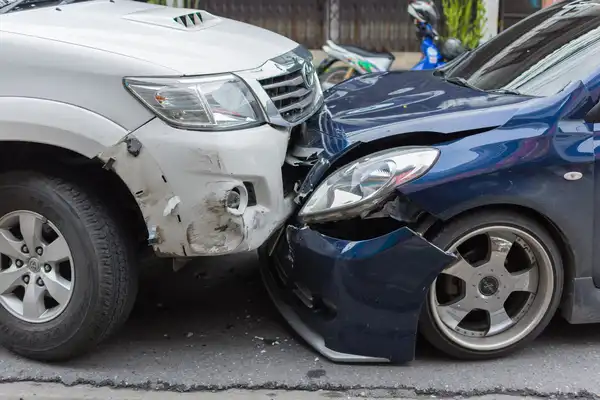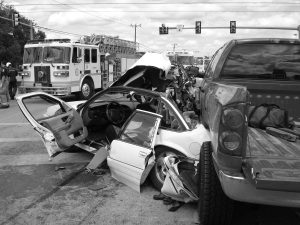
Free Consultation(203) 447-0000

Free Consultation(203) 447-0000

Millions of Americans visit the emergency room every year because of auto accidents, resulting in a grand total of more than a million days of hospitalization. Others, unfortunately, visit the morgue. Since what happens to your body in an auto accident can be gruesome in high-speed accidents, if you are squeamish, then you might want to think twice before reading the remainder of this post.
Accelerating to cruising speed in an automobile builds up a lot of kinetic energy, and the faster you travel, the more kinetic energy builds up. When your vehicle stops suddenly, as in a crash, this kinetic energy is suddenly released. Depending on how it is released, it can kill or seriously injure you.
Kinetic energy is released in three stages: first to your brakes, second to the body of your car, and third to your body. Hopefully, most of the kinetic energy has already been released into your brakes or into the body of the car before it reaches your body. Unfortunately, however, this is not always the case.
Frontal impact collisions are perhaps the most common type of auto accident. Although they look terrifying, frontal impact collisions are sometimes safer than other forms of collisions. The reason for this is that, in a frontal impact collision, you have the entire front of the car acting as a buffer between the impact and your body.
In addition, the fronts of cars (except vans) are designed to deform in a manner that dissipates kinetic energy to provide your body with maximum protection. The exception to this rule is head-on collisions where both cars are moving, because the impact of the force is doubled.
If you suffer one injury in a front-end collision, it’s probably going to be a broken collarbone. If you are driving, it will probably be your right collarbone, while if you are a passenger, it will probably be your left collarbone.
If the accident is more serious (in other words, if more kinetic energy is released all at once), your ribs will start to break. If enough of them break, your chest will start to lose its structural integrity. Don’t try to imagine what this looks like – it’s not pretty.
Once you’ve broken enough ribs and your chest starts to lose its structural integrity, the space between your lungs and your ribcage will start to cause problems. Your chest will expand as it always does while you are breathing, but your lungs will not expand with it.
This will have the effect of depositing air between your lungs and your ribcage, a condition known as pneumothorax. If your lung is punctured by one of your ribs, your life will be in serious danger.
In the most serious car crashes, parts of the vehicle may be forced into the vehicle’s cabin, striking and even penetrating the bodies of the occupants in the front seats of the car – even when they are wearing seat belts. Such incidents can result in broken bones, crushing injuries, and deep puncture wounds. Obviously, the risk of death is extremely high when something like this happens.
Seat belts do you the most good during a front impact collision, although even during a side impact or rear-impact collision, they can keep you from being thrown out of the vehicle. In a front impact collision, the main function of a seat belt is to prevent the steering wheel from penetrating your chest. Wearing a seat belt incorrectly, however, can cause your body great damage.
 Your seat belt needs to fit around the large part of your pelvis, not the soft tissue of your stomach or abdominal region. Very short or very large people may have trouble fitting into a seat belt, which is why special car seats are designed for children. If your seat belt is fitted over a soft part of your anatomy, great damage to your body can be done in the event of a collision, because all that kinetic energy will be released into an area that is not strong enough to absorb it.
Your seat belt needs to fit around the large part of your pelvis, not the soft tissue of your stomach or abdominal region. Very short or very large people may have trouble fitting into a seat belt, which is why special car seats are designed for children. If your seat belt is fitted over a soft part of your anatomy, great damage to your body can be done in the event of a collision, because all that kinetic energy will be released into an area that is not strong enough to absorb it.
If you wrap your seat belt around the soft tissue inside your stomach or abdomen, in the event of an accident, the seat belt will cut into your spleen, liver, stomach, and bowels like a knife through hot butter. This will release stomach acid and waste products into your general abdominal cavity, resulting in an extremely painful and life-threatening situation.
A seat belt holds you against your seat by two relatively strong parts of your body: your chest and your pelvis. If kinetic energy is released in a collision, it gets released into these relatively robust areas, minimizing your injuries. Don’t be surprised, however, if you suffer a broken collarbone, even if you are wearing a seat belt correctly.
One of the main reasons why death and serious injury are so common among people who don’t wear seat belts is that they absorb the kinetic energy of a crash so suddenly. Suppose, for example, that you are traveling in a car at 55 mph when a front-end collision causes a sudden stop.
Your body will continue moving at 55 mph until it reaches a firm barrier. If you are a passenger, this means the windshield, while if you are the driver, it means the steering wheel. And if your body impacts the steering wheel at 55 mph, there is no place for the steering wheel to go – except into your chest. Wear your seat belt, and wear it correctly.
Airbags are mandatory in most vehicles, and they have saved thousands of lives. The way airbags work is that, once the airbag’s sensors detect that the crash will be serious, it deploys instantaneously, using nitrogen instead of air. Holes in the rear of the airbag allow it to collapse relatively slowly, gradually releasing the kinetic energy that might have killed you if it had been released suddenly.
The speed of the car exerts a tremendous impact on both the likelihood of getting into an accident and the severity of any accident that does occur. The faster you drive, the less time you have to avoid a collision when an emergency occurs. If you are driving at 30 mph, for example, you will need over 100 feet to bring your vehicle to a stop to avoid a crash. If you increase your speed to 40 mph, however, you will need over 160 feet.
Speed also affects the likelihood of death by contributing to the severity of the impact when a collision does occur. In a 50 mph crash, for example, the risk of death is 20 times the risk of a 20 mph crash.
Side impacts are far more dangerous and difficult to defend against than frontal impacts. In a frontal impact, you have the entire front end of the car separating you from the initial impact, while in a side impact, all you have is the car door. Telltale signs of a side-impact collision include injuries to the thorax, injuries to the upper body, rib fractures, pelvic fractures, and damage to the lungs and other internal organs.
Side airbags exist, but they are not as effective at protecting your body as front airbags are. Most side airbags are draped across the top of the car across the side window. When the sensors detect an impact, the airbags deploy downward. This will protect your head and neck to some extent, but they are less effective at protecting the rest of your body.
Whiplash is the most common injury resulting from a rear-end impact. In a rear-end impact, your neck can get thrown backward before rebounding forward, stretching the muscles and tendons in the neck to the point of injury. Whiplash injuries can be extremely painful, but they can also be difficult to detect using medical instruments. Nevertheless, whiplash can cause serious damage to the neck, back, and spine.
If you were injured in an auto accident that was the fault of someone else, you are entitled to compensation for all of your damages. That doesn’t just mean medical bills. It means lost earnings, incidental expenses, pain and suffering, mental anguish, and perhaps other losses as well. You should pursue every penny of these damages. Berkowitz and Hanna know just how to pursue your claim in the most effective manner.
The tragic reality is that some people do not survive auto accidents, no matter whose fault the accident was. Although, obviously, the deceased victim cannot file a wrongful death lawsuit, the executor or personal representative of the deceased victim’s estate can do so. Damages go to the estate, itself, for eventual distribution to estate beneficiaries such as close relatives.
Damages can include:
Double or even triple damages may be awarded if the offending driver’s reckless disregard for traffic laws was a substantial cause of the victim’s death.
 If you have been injured in an auto accident that you believe may have been someone else’s fault, you might need to secure legal representation to conduct an investigation to determine whose fault the accident was. If the accident was someone else’s fault, you are certainly going to need legal representation to pursue your claim.
If you have been injured in an auto accident that you believe may have been someone else’s fault, you might need to secure legal representation to conduct an investigation to determine whose fault the accident was. If the accident was someone else’s fault, you are certainly going to need legal representation to pursue your claim.
Call Berkowitz Hanna today or simply contact us online, so that we can provide you with a free case consultation. We won’t charge you anything, ever, unless we win your case.
Berkowitz Hanna
